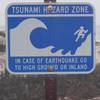Atlantic Hurricane Season Could be More Active
The Atlantic Ocean could be gearing up for an active hurricane season, meaning North American residents may want to pay attention.
In recent years, single hurricanes have led to thousands of deaths across the Caribbean, North and Central America, and have caused several billion dollars in damage.
When a hurricane bears down on a region, it not only puts people in peril, but it affects just about every major industry in the area, adding extra importance to the annual hurricane forecast.
On average, the Atlantic Basin observes around 11 named tropical storms, six hurricanes, and two major hurricanes during any given season, which runs from June through November. But those numbers could be a bit higher this year thanks to the atmospheric set-up that is currently brewing.
The expected introduction of a cool-water La Niña pattern in the Pacific over the next couple of months is generally favorable for tropical development. This, together with a few other dominant variables, will provide Mother Nature with all the ingredients to wreak havoc on the Atlantic Basin if she so wishes.
HURRICANE CRASH COURSE
Hurricanes need three main ingredients to form: warm sea surface temperatures, minimal to no wind shear, and an area of organized, long-lasting thunderstorms. These storms tend to originate off the western coast of Africa.
Wind shear simply characterizes how wind speed and direction change with height. Strong thunderstorms, and thus hurricanes, rely on strong vertical motion in the atmosphere. Too much wind shear prevents the vertical development of the storms, reducing their intensity.
Once formed, hurricanes must be fed by constant moisture to stay in business. When dry Saharan Desert air is transported into the tropics en masse, it disrupts tropical systems and essentially "starves" the storm to death.
The Atlantic hurricane season officially begins on June 1 and runs through Nov. 30. The peak occurs when the Northern Atlantic is at its warmest - around the second week of September - and this is statistically the most common time for a hurricane to occur.
However, hurricanes and tropical storms can form outside of this six-month window if the conditions are just right. In fact, the 2016 hurricane season already has one storm under its belt with Hurricane Alex, which formed under extremely rare circumstances this January.
Once a cluster of thunderstorms starts to display organized rotation with sustained wind speeds of 39 to 73 miles per hour, it is classified as a "tropical storm" and is assigned a human name by the U.S. National Hurricane Center. The name will stick with the storm through its life as a hurricane, if it becomes one.
Since 1953, the NHC has used an alphabetical fixed list of names that alternate male and female. Each list is cycled every six years, and storm names can be "retired" in any given year given the sensitive nature of particularly devastating storms. Recent retirees include Sandy, Katrina and Ike.
If sustained winds reach 74 mph, the tropical storm becomes a category 1 hurricane on the Saffir-Simpson scale, which rates hurricanes by intensity on a scale of 1 through 5, with 5 being the most extreme (http://reut.rs/25iK0NP).
If the winds increase to 111 mph, the hurricane is upgraded to a category 3. Hurricanes of categories 3 and above are considered "major" hurricanes.
Hurricanes are only labeled as such in the Atlantic Ocean and northeastern Pacific. A "hurricane" that occurs in the northwestern Pacific is called a typhoon and one that occurs in the Indian Ocean or Southern Pacific is known as a cyclone.
2016: PERFECT STORM?
One of the most important factors playing into this season is the imminent presence of La Niña, the cold phase of the eastern equatorial Pacific Ocean. La Niña tends to decrease the wind shear over the tropical Atlantic Ocean, which is one enabling ingredient in hurricane formation.
Therefore, it is not surprising that some of the more active hurricane seasons over the past several decades were often associated with La Niña. Seasons with below-normal hurricane activity have coincided with La Niña in the past, but this has not occurred since 1978 (http://reut.rs/1OJQKak).
Since 1950, the only above-average hurricane season to occur during El Niño was 2004, right in the middle of a four-year stretch of anomalously warm global oceans. The following year, 2005, remains the most active Atlantic hurricane season in recorded history.
But this year, both La Niña and warm oceans side with the hurricanes. Global ocean temperatures have been breaking new record highs over the past several months, meaning that together with reduced wind shear via La Niña, the atmosphere is practically rolling out the red carpet for the procession to begin.
And the favorability does not end there, as there should be plenty of fuel available for tropical development. Year-to-date precipitation over the African Sahel has been above average, which will reduce both the availability and distribution of dry, hurricane-disruptive air into the tropics during the season.
WHAT WE NEED TO KNOW
First and foremost, in no way should this forecast incite fear. An expected above-average forecast for the hurricane season does not specify whether these storms will make landfall. But either way, there are some important implications of these storms that should be considered.
The impact on commodity markets can be significant. Oil production in the Gulf of Mexico can grind to a halt if a hurricane is expected to approach. The Energy Information Administration projected that the Gulf produced 17 percent of U.S. crude oil in 2015. This is down from 27 percent in 2003, but any tropical disturbance in the Gulf could certainly give an upward jolt to generally suppressed oil prices.
Major agricultural commodities are generally less affected by hurricanes, although there are several instances where hurricanes made a difference. One occurred during the active hurricane season of 2012 when remnants of Hurricane Isaac traveled onshore to the U.S. interior in late August and gave parched soybeans a much-needed drink amid the historic drought.
Finally, there are things that we as humans need to remember. Hurricane advisories are generally issued several days in advance of the storm, and sometimes up to a week or more, so there is almost always enough time to prepare and evacuate if necessary.
If a hurricane watch is issued, then hurricane conditions are possible within the next 48 hours. A hurricane warning denotes that hurricane conditions are expected within 36 hours.
But keeping a close eye on the news and the weather will help to anticipate these watches and warnings several days in advance. Above all, anyone living along coastal areas of the western Atlantic Basin needs to keep alert for any such hazardous conditions and should follow all recommended measures, including evacuation, in order to ensure maximum safety.
Reporting by Karen Braun













